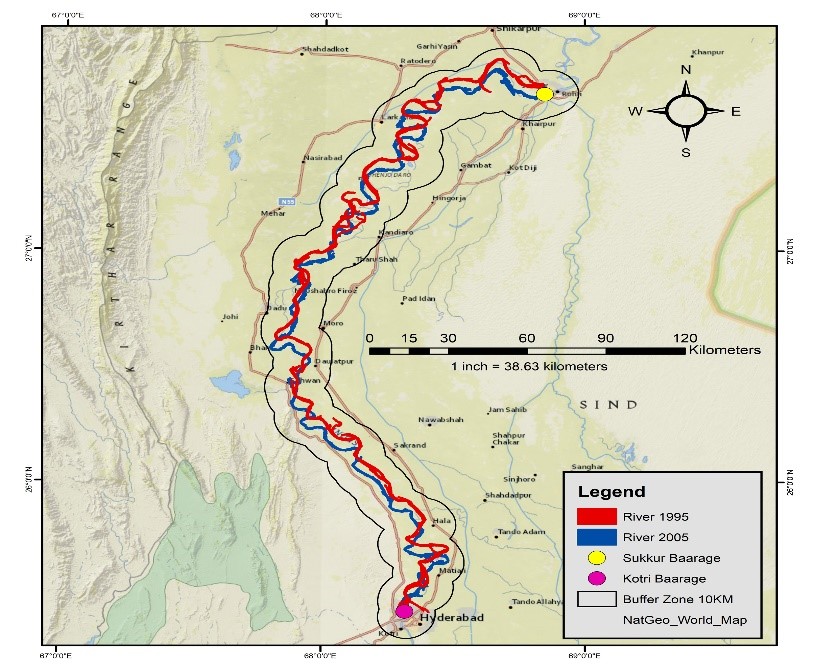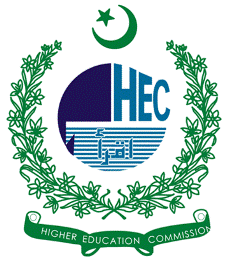Tracking Temporal Migration of the Indus River: Morphological Changes in a Downstream Reach
Keywords:
River Migration, Erosion, Accretion, Sinuosity Indices, Migration Rates, Geospatial Data and ToolsAbstract
Indus River morphological changes create environmental challenges, impacting local communities and ecosystems through fertile land loss, bank erosion, and higher flood risks. Monitoring these changes is crucial for flood and water resource management and infrastructure protection. This study uses geospatial data and tools to analyze spatial and temporal morphological dynamics of a downstream Indus River reach between the Sukkur and Kotri barrages from 1995 to 2024. Satellite imagery was analyzed to study morphological changes. Significant channel adjustments in river shape and form were observed, evident through erosion, deposition, and lateral shifts over the past three decades. The maximum erosion, covering 35,540 ha, and accretion, covering 23,737 ha, were observed between 1995 and 2005, with later periods showing reduced erosion and greater stability. The total cumulative erosion was 71,575 ha, and the total cumulative accretion was 64,790 ha, which gives a net loss of 6,785 ha. The sinuosity analysis showed that the meandering tendency of the river increased over the years as the sinuosity ratio increased from 1.82 in 1995 to 1.93 in 2024. These findings reveal the features of fluvial dynamics of the Indus River and stress the importance of reducing the adverse effects of these changes as necessary for the area's sustainable development.
References
J. P. Erich R. Mueller, “Sediment supply and channel morphology in mountain river systems: 2. Single thread to braided transitions,” J. Geophys. Res. Earth Surf., vol. 119, no. 7, p. 7, 2014, doi: https://doi.org/10.1002/2013JF003045.
C. S. C. Max G. Rozo, Afonso C.R. Nogueira, “Remote sensing-based analysis of the planform changes in the Upper Amazon River over the period 1986–2006,” J. South Am. Earth Sci., vol. 51, pp. 28–44, 2014, doi: https://doi.org/10.1016/j.jsames.2013.12.004.
Y. J. Weixia Jiang, Zigeng Niu, Lunche Wang, Rui Yao, Xuan Gui, Feifei Xiang, “Impacts of Drought and Climatic Factors on Vegetation Dynamics in the Yellow River Basin and Yangtze River Basin, China,” Remote Sens, vol. 14, no. 4, p. 930, 2022, doi: https://doi.org/10.3390/rs14040930.
D. J. Harbor, “Dynamic equilibrium between an active uplift and the Sevier River, Utah,” J. Geol., vol. 106, no. 2, pp. 181–194, 1998, doi: 10.1086/516015;PAGEGROUP:STRING:PUBLICATION.
S. Mitra, M. Purkait, A. Chatterjee, J. Dey, S. K. De, and L. Tamang, “Analysing the role of anthropogenic intervention in reconfiguring the hydromorphology of the sub-Himalayan river systems in India: a comparative assessment between the Mahananda–Balason and Chel–Neora systems,” Aquat. Sci. 2023 854, vol. 85, no. 4, pp. 1–22, Jul. 2023, doi: 10.1007/S00027-023-00988-2.
G. L. Harvey et al., “Evaluating the role of invasive aquatic species as drivers of fine sediment-related river management problems: The case of the signal crayfish (Pacifastacus leniusculus),” Prog. Phys. Geogr., vol. 35, no. 4, pp. 517–533, 2011, doi: 10.1177/0309133311409092;PAGEGROUP:STRING:PUBLICATION.
R. N. Biswas, M. N. Islam, M. N. Islam, and S. S. Shawon, “Modeling on approximation of fluvial landform change impact on morphodynamics at Madhumati River Basin in Bangladesh,” Model. Earth Syst. Environ., vol. 7, no. 1, pp. 71–93, Mar. 2021, doi: 10.1007/S40808-020-00989-2/METRICS.
M. K. L. Muhammad Waseem, Fahad Iqbal, Muhammad Humayun, Muhammad Umais Latif, Tayyaba Javed, “Spatial Assessment of Soil Erosion Risk Using RUSLE Embedded in GIS Environment: A Case Study of Jhelum River Watershed,” Appl. Sci., vol. 13, no. 6, p. 3775, 2023, doi: https://doi.org/10.3390/app13063775.
C. Y. Muhammad Waseem Boota, “Appraisal of hydro-ecology, geomorphology, and sediment behavior during low and high floods in the Lower Indus River Estuary,” J. Water Clim. Chang., vol. 13, no. 2, p. 2, 2022.
T. Ali, J. Rehman, and S. Zafar, “Validation of Altimetry Derived Water Levels for Mekong River,” Int. Geosci. Remote Sens. Symp., vol. 2022-July, pp. 7751–7754, 2022, doi: 10.1109/IGARSS46834.2022.9884034.
M. R. & M. A. U. R. T. Tauqeer Ali, Arjumand Zaidi, Jasra Rehman, Saif Haider, Stefano Vignudelli, Farkhanda Noor, Shahryar Jamali, “Enhancing Chashma Barrage water level estimations with sentinel 3 radar altimetry,” Discov. Water, vol. 4, no. 119, 2024, [Online]. Available: https://link.springer.com/article/10.1007/s43832-024-00179-6
M. W. B. C. Y. M. B. I. Z. L. S. S. M. D. M. Z. A. Yousaf, “Assessment of the morphological trends and sediment dynamics in the Indus River, Pakistan,” J. Water Clim. Chang., vol. 12, no. 7, pp. 3082–3098., 2021, doi: https://doi.org/10.2166/wcc.2021.125.
M. U. Insia Hussain, “Functional and Multivariate Hydrological Data Visualization and outlier Detection of Sukkur Barrage,” Int. J. Comput. Appl., vol. 178, no. 28, 2019, [Online]. Available: https://www.ijcaonline.org/archives/volume178/number28/hussain-2019-ijca-919097.pdf
S. Naz, S. S. Jamil, and M. J. Iqbal, “Archimedean copula-based bivariate flood-frequency analysis on Sukkur, Pakistan,” Arab. J. Geosci., vol. 13, no. 7, pp. 1–13, Apr. 2020, doi: 10.1007/S12517-020-5223-1/METRICS.
A. R. J. Sikandar Ali Channa , Abdul Qayoom Jakhrani , Sadam Hussain Jakhrani , Kishan Chand Mukwana, “Analysis of physicochemical and biological water characteristics of Phuleli canal,” Int. J. Adv. Appl. Sci., vol. 4, no. 6, p. 6, 2017, doi: https://doi.org/10.21833/ijaas.2017.06.013.
K. A. Daniyal Hassan, Steven J. Burian, Rakhshinda Bano, Waqas Ahmed, Muhammad Arfan, Muhammad Naseer Rais, Ahmed Rafique, “An Assessment of the Pakistan Water Apportionment Accord of 1991,” Resources, vol. 8, no. 3, p. 120, 2019, doi: https://doi.org/10.3390/resources8030120.
N. B. Md Masud Karim, “Cumulative impact assessment for Sindh barrages,” Impact Assess. Proj. Apprais., vol. 34, no. 4, 2016, doi: https://doi.org/10.1080/14615517.2016.1228341.
Q. B. P. Aqil Tariq, Hong Shu, Alban Kuriqi, Saima Siddiqui, Alexandre S. Gagnon, Linlin Lu, Nguyen Thi Thuy Linh, “Characterization of the 2014 Indus River Flood Using Hydraulic Simulations and Satellite Images,” Remote Sens, vol. 13, no. 11, p. 2053, 2021, doi: https://doi.org/10.3390/rs13112053.
Y. H. Dandawate and S. Kinlekar, “Rivers and coastlines detection in multispectral satellite images using level set method and modified chan vese algorithm,” Proc. - 2nd Int. Conf. Adv. Comput. Netw. Secur. ADCONS 2013, pp. 41–46, 2013, doi: 10.1109/ADCONS.2013.27.
A. K. Rai, V. Kumar, S. Patel, Z. Beg, and K. Gaurav, “Bootstrap Reduced Major Axis (BRMA) to optimize the satellite-derived discharge rating curves,” River Res. Appl., vol. 40, no. 8, pp. 1571–1583, Oct. 2024, doi: 10.1002/RRA.4325.
A. Cislaghi, P. Fogliata, E. Morlotti, and G. B. Bischetti, “Towards a better understanding of river dynamics in semi-urbanised areas: a machine learning analysis on time-series satellite images,” Mar. 2021, doi: 10.5194/EGUSPHERE-EGU21-3069.

Downloads
Published
How to Cite
License
Copyright (c) 2025 50sea

This work is licensed under a Creative Commons Attribution 4.0 International License.




















